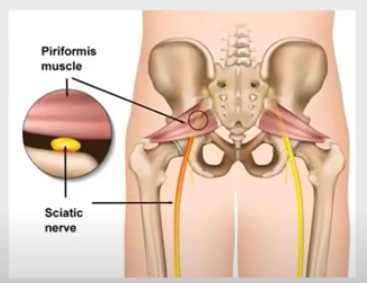What Is Piriformis Syndrome?

Q: What is piriformis syndrome, and how is it diagnosed and treated?
A: The piriformis muscle is a small muscle located deep in the buttocks region (behind the gluteus maximus) in the pelvis. Piriformis syndrome is a condition in which the piriformis muscle causes buttock pain. The sciatic nerve is a large nerve (formed from five nerve roots) that connects the spinal cord with the thigh, leg, and foot muscles. Sometimes the piriformis muscle can contract or spasm and compress the sciatic nerve against the bone. This irritation of the sciatic nerve may cause pain along the back of the leg. We sometimes see piriformis syndrome in athletes who might overwork their gluteal muscles (the large muscles in the buttocks.)
 There are several ways we can figure out the cause of sciatic nerve pain. As you may imagine, the area where the nerve roots are coming out from the spine is very tight. It can be challenging to tell if the pain is coming from the piriformis muscle or the lower back. We use several methods to help us figure out where the problem is. Electromyography (EMG) is a diagnostic procedure that measures the electrical activity of the muscle in response to stimulation. This can help us figure out where the compression might be. Medical imaging, such as an MRI, can also help us see what’s going on in the lower back. Lastly, there are injections to the piriformis that we can give patients to see if that helps relieve the pain.
There are several ways we can figure out the cause of sciatic nerve pain. As you may imagine, the area where the nerve roots are coming out from the spine is very tight. It can be challenging to tell if the pain is coming from the piriformis muscle or the lower back. We use several methods to help us figure out where the problem is. Electromyography (EMG) is a diagnostic procedure that measures the electrical activity of the muscle in response to stimulation. This can help us figure out where the compression might be. Medical imaging, such as an MRI, can also help us see what’s going on in the lower back. Lastly, there are injections to the piriformis that we can give patients to see if that helps relieve the pain.
Although it is rare, I do occasionally see piriformis syndrome, and it can be quite gratifying to see how well patients do when diagnosed and treated appropriately.
<–> Joshua Weaver, Weill Cornell Medicine Center neurologist
This question was answered during the episode of Spine Time called “The Source of Pain: How We Collaborate to Find out Where Your Back Pain Is Coming From.” A recording of this webinar held on June 24, 2020, is available on YouTube.
Sign up for our Back Pain mailing list to find out about spine news and events
